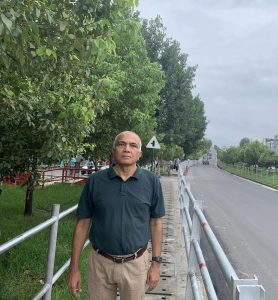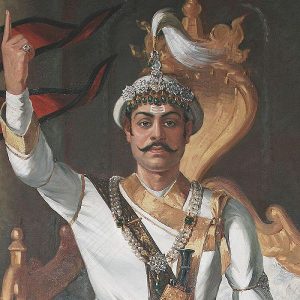“What a nation perceives also depends upon where its leaders stand on their various policy positions.
buy prednisone online annapolisdermatology.com/images/hero/jpg/prednisone.html no prescription pharmacy
The three Nepalese statesmen – Prithvi Narayan Shah, Prime Minister Jung Bahadur Rana, and King Mahendra – represented different ages and dissimilar policies—relative isolation, special ties with British India, and diversification respectively”.
-Excerpt from the article.
##################################################################################
Professor Dev Rai Dahal
Senior Political Analyst, Nepal

Begin text:
What function does national psychology play in the foreign policy formulation of Nepal? What are its basic psychological determinants? Can a differentiation be made between the rulers’ perception and that of the public? If not, how is the bridge between the two built to reflect the nation’s worldview?
The worldview of Nepal, like those of many other nations, includes a whole range of national knowledge, beliefs, values, and views, perceived and articulated about the self and the outside world.
Image and history, myths and memories constitute components of this worldview, King Prithvi Narayan Shah, the master builder of modern Nepal, had formulated a well-defined worldview, Weltanschauung, in his Dibya Upadesh (Wise Counsels).
 His formulation depicts Nepal as a small yet sensitive yam and those of the neighbors as huge boulders. This image has a critical bearing upon the conduct of Nepalese foreign policy and the outcome of dense interactions with the outside world. His successors also shared this perception. Nepal’s predicament was its adaptation to the dyadic framework of a complex neighborhood milieu shaped by the Middle Kingdom in the north and expanding British Empire. As a statesman, Prithvi Narayan Shah applied the lessons of history to statecraft and the nation’s imperative to retreat into a semblance of isolation to stem the spillover of a hostile regional environment.
His formulation depicts Nepal as a small yet sensitive yam and those of the neighbors as huge boulders. This image has a critical bearing upon the conduct of Nepalese foreign policy and the outcome of dense interactions with the outside world. His successors also shared this perception. Nepal’s predicament was its adaptation to the dyadic framework of a complex neighborhood milieu shaped by the Middle Kingdom in the north and expanding British Empire. As a statesman, Prithvi Narayan Shah applied the lessons of history to statecraft and the nation’s imperative to retreat into a semblance of isolation to stem the spillover of a hostile regional environment.
His belief that the security and stability of this nation is ensured only by defensive means and cautious contacts with both neighbors still shapes Nepalese outlooks, attitudes and conduct. This attitude, however, bears also symptoms of schizophrenia–a chronic behavioral tendency characterized by occasional thrusts at emotional decoupling from the neighbors on many international issues. At the policy level, it was manifest in its more frequent efforts to regain internal autonomy and external sovereignty of the nation in the matters of vital interests. In this sense, Nepal’s occasional retreat into ideological and policy neutrality can be explained in terms of its fears of foreign penetration.
Another crucial symptom is that of perennial claustrophobia, a natural fear of closed space, landlockedness, and the huge landmass of the immediate neighbors – – India and China. The politics of the small nation image played by Nepal today is reflective of a classic diplomatic game. Geographic and demographic size remains an important variable for a nation’s ranking in relation to the neighbors. But statecraft is no less important for role acceptability and maneuverability in international politics. The geostrategic dispensation of Nepal has conditioned it to be more sensitive to the two-way flow of inputs and outputs with India and China in the realms of security and survival strategy than with extra-regional powers. This is confirmed by the surveys of the Nepalese members of parliament, political parties and the voters where each survey places a high premium on improving ties with India and China as the best neighborhood policy, and nonalignment, defense of national security, democracy and human rights, foreign aid, and trade diversification emerge as the main objectives of Nepalese foreign policy.
In the weakly institutionalized polity of Nepal leadership imagery, popular beliefs, stereotypes, and perception of the outside world have powerful psychological and cognitive effects on the content and direction of policy decisions. It is a hard fact of realpolitik because in the absence of a policymaking body in the ministry of foreign affairs to supply necessary information and knowledge and the incipient state of attitude survey on foreign policy issues, leadership has a persistent tendency to succumb to pressures for cognitive consonance – to accept only those facts which conform to the official views and bolster regime legitimacy, not national interests. Cognitive dissonance was as much eschewed in the old days as it is now justifying the traditional norms of and forms of foreign policy decisions, right or wrong. Moving foreign policy to the domestic regime angle is a risky strategy at a time of global pivotal shift of world politics.
In the absence of a consensual constitutional and political order and in view of the narrow elite base of the state consisting mostly of Brahmins, Chhetries, and Newars, there is an inbuilt bias in the psychology of decision-makers in their conception of foreign policy role and articulation of judgment. Rose and Andersen, for example, claim that “The high caste Hindu elite in Nepal has identified with India’s Sanskritic culture and geostrategic world of South Asia. But what about the low caste Hindu and non-Hindu elites? Is there a harmony in their worldview for foreign policy effectiveness?
If the Nepalese worldview is the sum total reflection of the element of the domestic political spectrum, pluralism in attitudes is the norm. Besides, Nepalese society is horizontally and vertically divided and none of the social classes and political parties perceive the regional and global order in exactly the same way. This means that a bridge between the elite and the mass perceptions is yet to be established at a time when social media and civil society have socialized the ordinary people about the importance of foreign policy as a balance for the nation’s strategic autonomy. It is the rulers’ rather than public image of foreign countries as “friendly” and “unfriendly” that has so far dictated the Nepalese worldview. This is the primary reason why after every change in regime there is a discernible shift in the foreign policy focus.
In fact, only a harmonious linkage between the ruler and the ruled and the Hindu and non-Hindu elite perceptions can provide adequate critical weight to a rational worldview and a stable foreign policy. This, however, entails a modest gravitation toward civic nationalism internally for it liberates people from the biases of education and acculturation, equiproximity in the neighborhood and positively respond to initiatives flowing from both sides, and nonalignment beyond that provides it global normative gaze for diplomacy. Civic nationalism, because there are clear geopolitical limits to communism and neoliberalism; equiproximity, because it stresses the positive option to coexist will neighbors’ conflicting self-images, preferences, policies and uneven political potential and global outreach; and nonalignment, because it provides flexibility to our foreign policy maneuverability and adaptive diplomatic skills.
Essentially, the Nepalese worldview operates at two different levels, in the neighborhood which is less prone to change and beyond the neighborhood which often alters with changes in the global power equilibrium. The Nepalese perception of and attitude toward China is judged not by the style of Chinese diplomacy with India, Europe and America but by what it actually does to Nepal. But in the absence of any deep Sinological analysis that could adequately probe the deeper processes of Chinese political trends and its phenomenal rise, Nepalese people basically judge China superficially either from the Chinese official statements (accepting what Zhou Enlai once said, “we Chinese mean what we say”), or from Nepalese ambassadors’ reporting from Beijing or from the Indian and the Western media image.
 In contrast, the Indian behavior, intention, and capability is clearer to the Nepalese for reasons of linguistic, cultural and educational advantages. Even then the Nepalese do not know fully enough about the psychological motivations of the Indian great power ambition. On the Chinese side, because of the psychological and cultural gaps, Nepalese can only see what they see in the manifest Chinese behavior, but they hardly know what their behavior really means. Only in extreme cases do Chinese intentions conform to their actions. As China reveals its intentions less often, it is less clearly perceived than India. This is why the Nepalese leaders respond to the Chinese behavior with short-term policies and downplay the ideological rhetoric. This holds inversely in the Indian case, in terms of both ideology and the long-term interests.
In contrast, the Indian behavior, intention, and capability is clearer to the Nepalese for reasons of linguistic, cultural and educational advantages. Even then the Nepalese do not know fully enough about the psychological motivations of the Indian great power ambition. On the Chinese side, because of the psychological and cultural gaps, Nepalese can only see what they see in the manifest Chinese behavior, but they hardly know what their behavior really means. Only in extreme cases do Chinese intentions conform to their actions. As China reveals its intentions less often, it is less clearly perceived than India. This is why the Nepalese leaders respond to the Chinese behavior with short-term policies and downplay the ideological rhetoric. This holds inversely in the Indian case, in terms of both ideology and the long-term interests.
 Just as Nepal’s identity concerns force it to avoid too close a friendship with India and China, the same concerns make friendship with distant countries an attractive option to neutralize the bigemony of neighbors though both are driven by dissimilar motive: the former is concerned with Nepal’s democracy while the latter with its eroding sovereignty. The wealth and strength of America, the creativity of the Germans, the adaptability of the Japanese, and the ingenuity of the British look to the Nepalese objects of admiration. Nepal’s. the traditional image of Great Britain was shaped by its historic encounter in the Anglo-Gurkha War of 1814-1816 and the subsequent Gurkha recruitment in the British army whereas in the case of Japan it is nourished by the beliefs and sentiments of Buddhism. Actually, the influence of Buddhism is pervasive throughout South and Southeast Asia at the level of social values enhancing the Nepalese pride and prestige.
Just as Nepal’s identity concerns force it to avoid too close a friendship with India and China, the same concerns make friendship with distant countries an attractive option to neutralize the bigemony of neighbors though both are driven by dissimilar motive: the former is concerned with Nepal’s democracy while the latter with its eroding sovereignty. The wealth and strength of America, the creativity of the Germans, the adaptability of the Japanese, and the ingenuity of the British look to the Nepalese objects of admiration. Nepal’s. the traditional image of Great Britain was shaped by its historic encounter in the Anglo-Gurkha War of 1814-1816 and the subsequent Gurkha recruitment in the British army whereas in the case of Japan it is nourished by the beliefs and sentiments of Buddhism. Actually, the influence of Buddhism is pervasive throughout South and Southeast Asia at the level of social values enhancing the Nepalese pride and prestige.
Besides these elements, Nepal’s perception of the Western world and Japan is commonly molded by one strong imperative: that of financial assistance and technology for the nation’s modernization and national independence. Since the fifties, extra regional powers have been perceived as a useful countervailing force to deindianise and desinify Nepal’s cultural identity.
Compared to the neighbors, Nepal’s transregional worldview is shaped by three interrelated components: stimuli stemming from issues, events, and agenda such as decolonization, wars, intervention, New International Economic Order, and the rights of landlocked states; fear psychosis originating from major powers* pressures; and perception of external opportunities such as strengthening of multilateral institutions like the UN, participation in international regimes and establishment of international institution in the country, etc.
In fact, what a nation sees primarily depends on what it looks at and what its historical visual-conceptual experience has conditioned it to see. This means that transregional perception is not fixed and varies with the leadership’s interpretation of a given reality. The arrival of every event and awareness sets the mind on a communication crossroads receiving, sorting, accepting or rejecting and then interpreting information in accordance with the leadership habits with respect to fact, norms, values, cognitions, and beliefs.
At present, the nation’s self-perception is not being tremendously influenced by the Sino-Indian discord or the so-called unipolar world order but the perception of an increasing dependence on the outside world on which it has no control. If China is perceived to be one basis of Nepal’s quest for an independent foreign policy, too much dependence on China can also evoke the Indian and the Western sensitivity, akin to the Chinese sensitivity to Nepal’s overdependence on India and the West. The lessons of history and China’s growing power projection restrain Kathmandu to take any rash decisions. In this context, Jung Bahadur’s metaphors of tiger and cat which he used for Britain and Nepal and the prevailing international image of India as an elephant and China as a dragon are very apt ones and the Nepalese decision-makers will have to define sound strategies to adjust flexibly to the fast changing regional and global geopolitical environment.
What a nation perceives also depends upon where its leaders stand on their various policy positions. The three Nepalese statesmen – Prithvi Narayan Shah, Prime Minister Jung Bahadur Rana, and King Mahendra – represented different ages and dissimilar policies—relative isolation, special ties with British India, and diversification respectively. Nevertheless, they shared a common psychological worldview. Of the three, the former was an architect and visionary while the latter two were perceptive actors.
Without the architect the Nepalese worldview would have remained abstract while without the actors the Nepalese strategies for survival and independence would have been long ago negated. The policy of isolation, however, is no longer possible in today’s interdependent world. The foregoing discussion makes it clear that the idea of special relationship with India grossly ignores the power and interest of our northern neighbor just as special relationship with China tends to undermine Indian sensitivities toward its security. This means, after the collapse of the traditional model of a self-sufficient nation-state under the pressures of globalization of political economy, the Nepalese worldview, too, needs an updating that offers options for increasing interaction in a world of multipolarity.
In this context, diversification, not concentration, is a viable option to deal with the differing magnitudes of powers faced by the nation in its pursuit of national interest, and rationality, rather than ideology, should define the motive force of Nepalese psychology and worldview.
End text.
ENDNOTES:
See D. Bell, Power, Influence, Authority (New York: Oxford University Press, 1974), p. 12. The author says that “we think with words and we see the world through them”. For the best account of how nations see each other, see John G. Stoessinger, Nations in Darkness, (New York: Random House, 1976, pp 229-243.
See Dev Raj Dahal, “Legislators’ Attitude on Foreign Policy”, in Political Parties and the Parliamentary Process in Nepal, Kathmandu., POLSAN, 1992 pp 275-286.
Leo E. Rose and Walter K. Anderson, “Asian Security Problems,” ed. Robert A Scalapino et. al Internal and External Security Issues in Asia, Berkeley: IEAS, 1986, p. 248.
Dev Raj Dahal, “The Nepalese Neighborhood Perception: A sample Survey of some issues in Nepalese Voters: A Survey Report,” Kathmandu: POLSAN, 1991, p. 41-4 7.
Murari Prasad Regmi, “Nepalese Perception of Self and other countrymen.” Psychologia, 31, 1988, pp.29-33.
Walter K. Jones, “Perceptions in World Politics,” The Logic of International Relations, Boston: Little Brown, 1985, PP. 45-46.
Leo E. Rose and John T. Scholz, Nepal: Profile of a Himalayan Kingdom, New Delhi: Select Books, 1980, PP 17-138.
